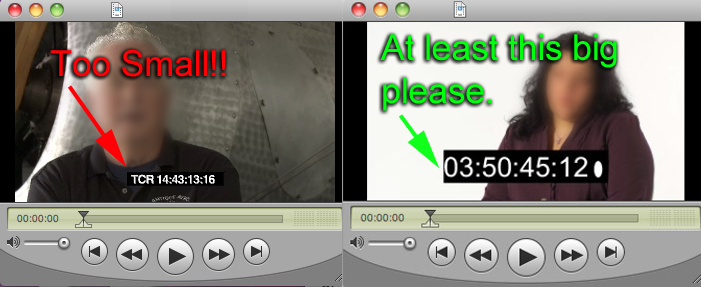Timecode inserted every 30 seconds:
We will insert the visible timecode at the beginning of each answer and approximately 30 seconds thereafter. Thus if an interviewee gives a 60 second response to a question, there would be a time code mark at the beginning of the answer and approximately 30 seconds later.
If submitting a file of ‘selects-only’ with all questions and off-screen direction edited out, we will only insert a timecode mark for every 30-seconds of wall clock, not each individual select. We do not timecode each select of audio in this case. If you are submitting a ‘selects-only’ media file, please insert a 1 to 3 second piece of slug (right-click to download) between each select. Unless slug is inserted between each select, we are unable to guarantee that each response will be identified as a separate take.
Example:
Q: So why don’t you tell me where you’re from?
+++ 01:02:23 +++
John Doe: I’m from a little town north of San Francisco, near the coast. I was born and raised there and didn’t move away until last year.
Timecoding on normal transcripts is accurate to about +/- 3 seconds.
If your footage is unstructured like Reality TV dailies, then we just insert a timecode mark every 30 seconds if there is no obvious place to mark the beginning and end of an audio response. (e.g. a lot of people chatting amongst themselves.)If you edit a series of clips together, we will only insert the timecode mark every 30 linear seconds of the run time, not at the change of each snippet unless there is at least 3 seconds of 1khz tone marking the change of each snippet. An example of this would be a ‘cut-down’ of an interview where only select snippets are tied together one after another with the questions removed. The 3 second gap is important as it helps the transcriber determine when the snippets change.
We do not place a timecode mark on the questions asked, only the answers given.
How big should I burn my Window Burn?
The timecode needs to be readable by a human transcriber ‘on-the-fly’. Also, the transcriber will only be watching a small screen similar to the size of an iPhone, not full screen. As such, please make sure the timecode is relatively as large as the image on the right. The image on the left is too small. We also prefer white text on a black background. If you can’t render a black background, please a vibrant color like ‘purple’ or ‘red’ for the text that will overlay on the image.
What’s the price for timecoded transcripts?
Timecoding is available only on certain kinds of transcription. If you are on a type of transcript for which timecoding is offered, you will see the additional price-per-minute charge for timecoding.
See the Type-1 or Type-2 pricing box for One-on-One Interviews as an example.
Timecode Transcription Formats
We can create timecoded transcripts from the following types of media:
- DVDs or digital video files with a visible timecode burn (BITC). See guidelines for video duplication.
- Audio files with audible SMPTE LTC timecode on one of the channels.
- BWF and IXML Broadcast WAV files.
- Quicktime MOV files with embedded timecode metadata
- mp3s with SoundDevices id3 metadata timecode information. Certain Sound Devices recorders can generate suitable mp3s with metadata.
As of January 1, 2009 VHS is considered a ‘dead’ format, additional charge will apply if you submit a large order of VHS tapes.
Effects on Turnaround
Generally speaking timecoding or timestamping will add one business day to any normally listed Normal Turnaround Time. If Rush Service is selected, then there is no additional turnaround time. Rush files are delivered next business day whether timecode is selected or not.
Timestamping Transcripts
We can also provide timestamps in lieu of timecode when materials are submitted without any Visible or Audible timecode. Time stamping only references the head of the counter and WILL NOT match your master tapes. Time stamping starts at 00:00:00.
